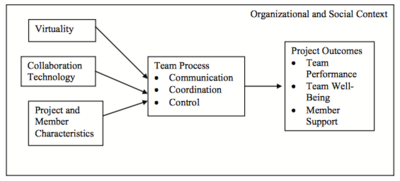Virtual project management

Contents |
Overview
New dimension into project management appeared with the rise of the Internet and development of collaborative software.
Definitions
Virtual program management (VPM) is management of a project done by a virtual team, though it rarely may refer to a project implementing a virtual environment It is noted that managing a virtual project is fundamentally different from managing traditional projects, combining concerns of telecommuting and global collaboration (culture, timezones, language). [2][3]
A Virtual Team – also known as a Geographically Dispersed Team (GDT) – is a group of individuals who work across time, space, and organizational boundaries with links strengthened by webs of communication technology. They have complementary skills and are committed to a common purpose, have interdependent performance goals, and share an approach to work for which they hold themselves mutually accountable. Geographically dispersed teams allow organizations to hire and retain the best people regardless of location.[4]
Virtual team is an alternative to the traditional form of business organization, which is characterized by the presence of a physical office. However, in practice, more common is the mixed model, in which the company has a physical office, is used to solve most of the problems of remote workers, outsourcing or freelancing.
Types of Virtual Teams
Networked Teams consist of individuals who collaborate to achieve a common goal or purpose; membership is frequently diffuse and fluid.
Parallel Teams work in short term to develop recommendations for an improvement in a process or system; has a distinct membership.
Project or Product-Development Teams conduct projects for users or customers for a defined period of time. Tasks are usually non- routine, and the results are specific and measurable; team has decision- making authority.
Work or Production Teams perform regular and ongoing work usually in one function; clearly defined membership.
Service Teams support customers or the internal organization in typically a service/technical support role around the clock.
Management Teams work collaboratively on a daily basis within a functional division of a corporation.
Action Teams offer immediate responses activated in (typically) emergency situations.
References
- ↑ "The Practice and Promise of Virtual Project Management", http://www.isqa.unomaha.edu/dkhazanchi/vita/Research%20Papers/91.pdf
- ↑ Velagapudi, Mridula. "Why You Cannot Avoid Virtual Project Management 2012 Onwards" April 13, 2012 http://blog.bootstraptoday.com/2012/04/13/why-you-cannot-avoid-virtual-project-management-2012-onwards/
- ↑ Global Knowledge."Virtual Project Management (course)". http://www.globalknowledge.com/training/course.asp?pageid=9&courseid=10276&catid=196&country=United+States
- ↑ "Definition of Virtual Teams", http://managementhelp.org/groups/virtual/defined.pdf